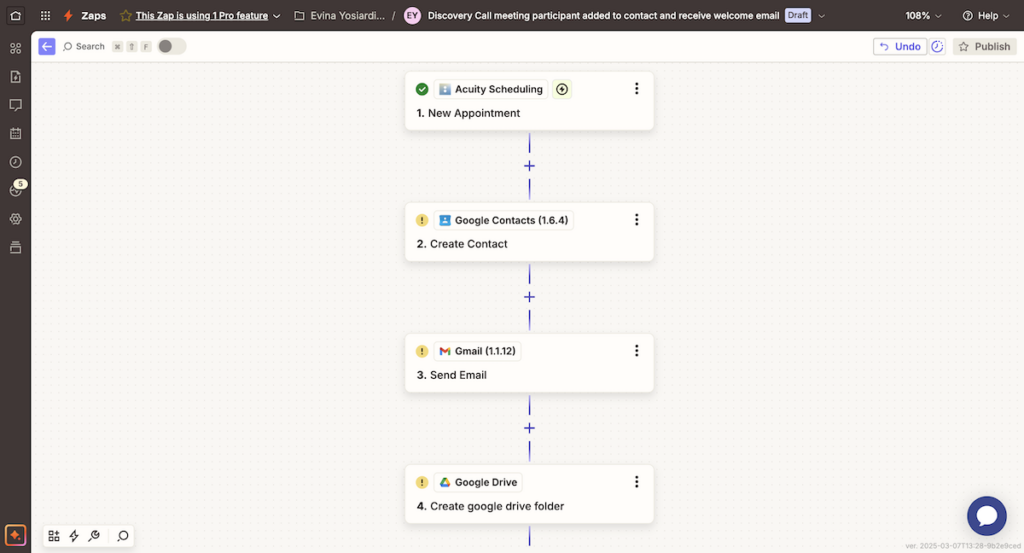Drowning in endless tasks and constant demands? You’re not alone. For business owners and professionals, time often feels like the enemy. But here’s the truth: simplifying isn’t rocket science. A few smart systems and automated tools (hello, Zapier and Notion) can slash repetitive work and clear up your day. Less chaos, more progress—without the burnout. Why work harder when you can work smarter?
Why Life & Business Feel Messy Without Systems
Do you ever feel like you’re being pulled in a million directions at once? Maybe your email inbox is overflowing, deadlines are sneaking up on you, or you’re constantly scrambling to find important documents. Life and business can feel like pure chaos without the right systems in place. I get it—when things are messy, it’s hard to focus. You’re busy putting out fires instead of working on the stuff that actually matters. So, what’s really going on here? Let’s break it down.
The Hidden Chaos Costs You Time
Think of your day like a bucket. Every time you stop to search for information or redo a task because it wasn’t done right the first time, it’s like poking holes in that bucket. Before you know it, all your energy and time have drained away, leaving you frustrated and overwhelmed.
A lack of systems means you spend more time sorting through unnecessary clutter—both literally and figuratively. Whether it’s disorganized files or unclear workflows, these small delays quickly add up. Have you ever wondered what your day would look like if all that wasted time was streamlined into focused, high-impact work instead? Systems keep those bucket holes plugged.
Mental Overload Leaves You Exhausted
Without systems to rely on, you’re forced to keep track of countless details in your head—schedules, client information, project deadlines, priorities… It’s no wonder you’re exhausted! This kind of mental overload doesn’t just stress you out; it makes you less productive. Studies repeatedly show that multitasking kills efficiency.
When we juggle tasks manually without clear workflows, we’re essentially living in “reactive mode.” You’re always responding, always behind, and rarely in control. Systems are like a mental cheat sheet—letting you offload all that cognitive clutter so you can actually breathe.

Disorganization Hurts Productivity and Reputation
Here’s the harsh truth: messy processes can kill your credibility. Missed deadlines, lost opportunities, or forgotten follow-ups don’t just inconvenience you—they might cost you clients or damage your professional reputation.
When your business runs without systems, customers and collaborators notice. Maybe you forgot a small detail in a project. Or maybe you’re constantly explaining delays by saying, “I’m just so busy.” That doesn’t inspire trust. But when systems automatically handle these mundane or repetitive tasks, things look (and feel) polished, even during busy seasons!
Systems Simplify Life and Work
Here’s the thing: having a system doesn’t mean things have to be rigid or inflexible. In fact, the right systems add both structure and freedom to your day-to-day. Think about meal prepping for the week. Sure, it takes some upfront planning, but it saves you a ton of time and stress later, right? The same principle applies to your business.
When you know exactly where to find information, which tools handle certain tasks, and what automations you can put on autopilot, life opens up. Suddenly, you’re not spending hours on repetitive busywork anymore. You can focus on growth or simply enjoy some downtime without guilt.
What Happens if You Don’t Fix It?
If you keep ignoring the lack of systems, this messy cycle will only get worse as your business grows. Take a moment to think: Are you really willing to tolerate this stress a year from now? Five years? Running without systems might feel manageable in the moment, but as things scale, the cracks become gaping holes. Just how sustainable is letting the chaos dictate your life?
I remember a client who was so overwhelmed with their daily operations, they didn’t even know what to say during our discovery call. They felt stuck, juggling too many tasks and constantly putting out fires. Once we started introducing simple systems and tools, things started to click. Suddenly, they had more time to focus on growth instead of just surviving the day-to-day. It was a game-changer for their business.
Key Takeaways:
🔑 Feeling like chaos runs your day? You’re not alone. Without smart systems, disorganization eats up your time and sanity. The fix? Simple systems and automation. They’re not rigid—they’re freedom. Get back control, focus on what matters, and finally ditch the overwhelm.
What Are Systems & Why They Work?
Systems might seem like a “corporate buzzword,” but here’s the truth—they’re the backbone of efficiency. Systems free you up for what truly matters: growing your business or even just reclaiming a little sanity. Think of a system like a well-oiled machine. Once it’s set up, it keeps running without constant oversight, allowing everything around it to function smoothly.
The Role of Automation in Productivity Systems
Automation bridges the gap between what you need done and how it gets done—all without requiring your constant involvement. The beauty of automation tools is that they simplify business processes, saving time and energy for tasks that actually require your attention.
Take tools like ClickUp for instance. It’s a lifesaver for tracking tasks, sharing updates with your team, and keeping priorities in check. Want to connect the dots between different apps without manually entering data? Zapier is a game-changer. It seamlessly sends information from one tool to another, cutting out all the repetitive steps. Just imagine: no more copying and pasting, no more worrying about missed updates.
Why spend hours on tasks that software can accomplish in minutes? When your systems are automated, you’re not just simplifying your business—you’re building an environment where things run effectively without running you into the ground.
How Strategic Workflows Prevent Burnout
Burnout isn’t just about exhaustion—it’s about feeling like you’re unable to manage everything coming your way. Strategic workflows are here to flip the script, giving you more structure and reducing overwhelm.
One powerful method is task batching. This means grouping similar activities together, like scheduling an hour for client calls rather than scattering them throughout your day. When you’re focused on related tasks, your brain doesn’t have to constantly switch gears, which keeps energy levels steady. Another trick? Using detailed, repeatable processes. Instead of reinventing the wheel every time you onboard a new client or post a blog, having a set process keeps things efficient and predictable.
Workflows save time and protect your energy. By cutting down decisions, you stay focused and productive. Clear workflows also boost job satisfaction since you know what’s doable. For burnout tips, check out this article.
A solid system doesn’t just check off tasks—it keeps your mind clear and your day more enjoyable.
Let me ask you this: What tasks in your business constantly weigh you down? If you could automate or rework just one process, which would it be?

7 Simple Systems to Automate & Simplify Your Business
Running a business is hard enough without wasting time on repetitive tasks. Use simple systems and automation to save time and focus on growing your business. Here are seven tools to keep things running smoothly.
Task Management System
Both tools help you manage tasks efficiently. You can create, assign, and track progress with ease. ClickUp offers a flexible layout that’s great for visual planners and handles complex projects well. Asana keeps things simple and organized, making it easy to set priorities, deadlines, and reminders. Both are powerful options, so it comes down to what fits your style best.
It’s like having a virtual assistant keeping everything organized. Once you start using these tools, sticky notes won’t cut it anymore.
Lead Generation Automation
Keeping your sales pipeline full can feel like a full-time job. Luckily, tools like HubSpot and Mailchimp take the hard work out of lead generation. These platforms integrate with your website to automatically capture visitor information, add them to your CRM, and send nurturing emails.
You’ll love the workflows you can build. Imagine this: A potential customer fills out a form on your site, and within minutes, they’ve received a personalized email welcoming them. You didn’t have to lift a finger! Automated lead nurturing keeps the conversation going without you having to manually follow up every time.
Scheduling & Appointment Management

Nothing kills productivity like endless back-and-forth to schedule calls or meetings. Tools like Calendly and Acuity streamline the process by allowing clients to book directly based on your availability. It will even create a Google Drive folder for clients so you can store their meeting notes, contracts or invoices!
Here’s how it works: You share your calendar link, and clients can pick a time that works for them. These platforms even account for time zones and can send reminders ahead of appointments. Whether you’re scheduling coaching calls or consultations, this system saves you hours of email tag and keeps your schedule organized.
E-Mail Automation System
Email marketing doesn’t have to be a time drain. Tools like ConvertKit and ActiveCampaign automate tasks like onboarding new customers, sending follow-up emails, or promoting new services.
Say you onboard a client: Instead of manually sending them a welcome email and resources, set up an automation to handle it. Pre-scheduled sequences mean you can build deeper customer relationships without being glued to your inbox. These tools are a lifesaver for staying consistent in your email communication.
Financial Tracking System
Ah, the dreaded financials. But let’s make it simple. Platforms like QuickBooks and Wave help automate everything from expense tracking to invoicing. You can sync your bank accounts, automatically categorize transactions, and generate monthly reports without the manual headaches.
Wave, for instance, is free and great for small service-based businesses. QuickBooks adds more robust features if you’re managing inventory or payroll. Whichever you choose, these tools ensure your finances stay organized, so tax season doesn’t sneak up on you like a bad surprise.
Social Media Content Scheduling
Consistency is key when it comes to social media, but who has the time to post content daily? With management tools like Buffer and Hootsuite, you can plan, schedule, and automate your social media posts across multiple platforms.
These platforms allow you to upload posts weeks in advance, ensuring your online presence stays active even when you’re focused on other priorities. Got a promo running in two weeks? Schedule all the creatives now and forget about it! It’s like having a social media assistant, but way cheaper.
File Management System
Tired of digging through cluttered folders to find one file? Tools like Google Drive and Dropbox keep everything organized and accessible in one place. Both platforms allow for easy file sharing within teams, eliminating those endless “Can you send that doc again?” emails.
One of the best parts is real-time collaboration. Whether it’s editing a proposal or sharing a large batch of files with a client, these systems keep everyone on the same page without the back-and-forth.
Which of these systems would make the biggest difference in your daily workflow? Let’s face it—we could all use a little extra time in our day.

Actionable Steps to Implement Today
Ready to simplify your business and save time? Start small. Focus on these three easy steps today to streamline your workflow.
Step 1: Identify Your Bottlenecks
Pull out a notebook or open your favorite task manager—this is where the magic starts. Take an honest look at your workload and list all the tasks or processes that consume way too much of your time. Pay close attention to repetitive or manual activities that often get in the way of higher-value tasks. Think about things like manually responding to emails, chasing invoices, or creating reports from scratch every time.
Not sure where to start? Imagine your daily workflow as a traffic jam. Where do things seem to slow down or stall the most? That’s likely your bottleneck. For instance, if you’re missing deadlines, it could be due to poor task prioritization. If you’re constantly re-explaining processes to your team, it might be a lack of documentation. Once you’ve identified these pain points, you’ll have a clear target for improvement.
To learn more about pinpointing bottlenecks effectively, check out this guide—it’s packed with tips to help simplify your efforts.
Step 2: Choose the Right Tools
Now that you know what’s slowing you down, it’s time to choose the right tools to make things smoother. There are countless options out there—ranging from full-featured project management platforms to simple, no-code automation tools. The key? Focus on tools that align directly with your needs.
Before committing to any tool, spend a few minutes researching its features and, if possible, take advantage of free trials to make sure it works with your workflow.
Pro tip: Don’t fall into the trap of using multiple tools that do the same job. Simplification is the goal here. Keep your tech stack streamlined by sticking to one or two tools per category (e.g., task management, financial tracking). For example, platforms like Zapier are a fantastic starting point for automating repetitive tasks across apps.
Step 3: Start Simple and Build Gradually
Here’s where many people stumble: they try to automate or systematize everything all at once. Not only is that overwhelming, but it’s also counterproductive. Instead, identify one process to automate first—this could be something as simple as scheduling social media posts a week ahead or sending automated follow-up emails to new leads.
Once you’ve implemented one system, take a step back and evaluate. Is it saving you time? Does it reduce your mental load? If yes, move on to the next task you want to streamline. By focusing on gradual progress, you’ll build confidence and avoid feeling buried under too many new workflows at once.
Need inspiration for where to begin? This article on how to start automating business processes outlines practical steps to ease into automation without the headaches.
Conclusion
Simplify your business with small changes that build over time. Automate tasks and set up systems to reduce stress and focus on what matters. Start by tackling one chaotic area today, like setting up lead generation or automating emails. Small steps lead to big improvements.
So, what’s the first system you’re going to set up? I’d love to hear about it in the comments!
Leave a Reply